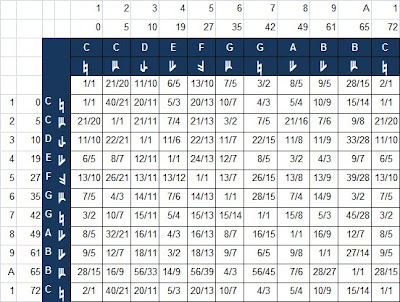This is a final version of this piece. It steps through eight 5 & 6 note combinations of the ten note scale, about two minutes for each. There’s a vamp, then a melody, then some variations for each one. The character of each is quite different. I also change the bass note twice. It starts on the 1:1, then goes up to the 8:7, back to the 1:1 then later down to the 12:7. When on the 8:7 and 12:7, the bass reinforces the other notes in a harmonic series, for the most part, so they are more consonant. The other scales are more challenging. Think of it as a sushi bar where you get some California Roll mixed in with omakase (literally “trust the chef”). Is that squid moving? See 8:30 for the 716A48 chord.
Here’s a matrix of the ten notes and the ratios one to the other:

The ten note scale is from top to bottom on the left: 1:1, 15:13 8:7 26:21 9:7 10:7 3:2 12:7 13:7 27:14 and 2:1. This set can also be thought of as 14:14 15:14 16:14 26:21 18:14 20:14 21:14 24:14 26:14 27:14 28:14, almost all a part of the overtone series. The key difference is that the root of the scale, 14:14, is the seventh overtone of the other notes in the scale, instead of the first. Putting that 7th in the base shakes things up a bit. And I can move it around to reinforce the harmonic series for contrast.
The piece starts out with a mode made up of stacked fourths, and proceeds to change them. Here’s the list, with the number indicating the scale degree out of the ten in the matrix.
- A58371
- 26A583
- 371615
- 483716
- 583716
- 615837
- 716A48
- 83726A
- A58371
For the second one, 26A583, I move the bass down to the 12:7, so it’s consonant with the other notes in the series. 26A583 is made up of the ratios 15:14 10:7 27:14 9:7 12:7 8:7. But if you assume the 12:7 is in the bass, then the ratios relative to that 8:7 become 5:4 5:3 9:8 3:2 1:1 4:3. Those are all in the harmonic series relative to the A at scale degree 8, except for the 4:3, which is not. But it sounds so sweet I had to leave it in. All these five or six note scales, derived from the ten, were chosen because they sound good in stacked fourth chords. I just couldn’t resist the 4:3 relative to the root on A. It’s not too removed from the overtone series after all.
The bass moves back to the 1:1 for a while, until about 3/4 of the way through when it shifts to 615837, when I use the 8:7 in the bass. The ratios relative to the 8:7 for that set of six notes are 5:4 7:4 9:8 3:2 1:1 21:16. That 21:16 is not in the overtone series. And it’s a 64:63 away from a 4:3 above the 1:1 in the scale. But it’s close enough to fake it in this context as part of the melodic flow.
Play it here
or download this link
Subscribe here: 





